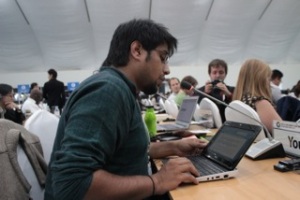Dispatches from Pyeong Chang, S. Korea
Kabir Arora
The following intervention was made on agenda item number 29 “Stakeholder Engagement” and “Engagement with Sub-national and Local Governments” of draft decision text in Working group II dealing with Ecosystem Conservation and Restoration.
Madam Chair, thank you for giving us this opportunity. I’m speaking on behalf of Global Youth Biodiversity Network. We would like to thank Secretariat for including ‘Youth’ as stakeholders in item number 29 section on “s takeholder engagement” in Paragraph 3 & 4 of the draft decision text:
takeholder engagement” in Paragraph 3 & 4 of the draft decision text:
“Encourages Parties to promote practices and mechanisms to enhance the participation of stakeholders, including youth, in consultations and decision-making processes related to the Convention and its Protocols at the regional and national levels;
Calls upon Parties to effectively engage stakeholders, including youth, in the development and implementation of the new generation of revised national biodiversity strategies and action plans, and to support initiatives that seek to promote such participation;”
And we also recommend that parties should be invited for inclusion of ‘youth’ as partners for local governments in the item number 29 section on “engagement with sub-national and local governments” Paragraph 5. And propose an addition to the same paragraph i.e. “engaging all relevant stakeholders including youth” and we suggest that the paragraph should read as follows:
“Encourages sub-national and local governments, engaging all relevant stakeholders including youth, to contribute to the attainment of the Strategic Plan for Biodiversity 2011-2020 by, specifically, integrating biodiversity considerations into plans for sustainable urbanization, including local transport, spatial planning, water and waste management; promoting nature-based solutions; monitoring and assessing the state of biodiversity and progress to preserve it; integrating biodiversity conservation as a solution to climate change; and prioritizing biodiversity issues by showcasing the positive effects of biodiversity and ecosystem services on other topics, such as health, renewable energy and livelihoods;”
As local governments can utilize energies and experiences of young people for strengthening urban environmental governance framework and implementation of various programmes mentioned in the draft convention text.
Thank you Madam Chair.

